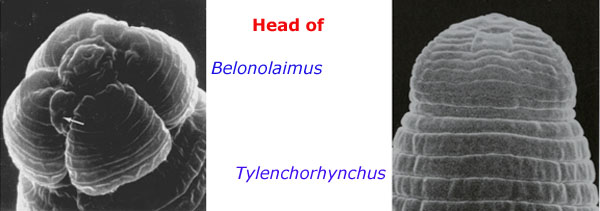
The Family Belonolaimidae
![]()
![]()
![]()
![]()
![]()
Constructed and maintained by Khuong
B. Nguyen
University of Florida

The Family Belonolaimidae
![]()
![]()
![]()
![]()
![]()
Constructed and maintained by Khuong
B. Nguyen
University of Florida
Diagnosis: Tylenchoidea. Medium- to large-sized
nematodes with tail cylindroid to conoid, more than twice as long as wide
but
never elongate filiform.. Stylet slender, occationally
very long. Lateral field with 1-6 incisures. Phasmids on posterior half
of tail,
never enlarged. Lip region with 4 lips and 2
reduced ones or with six sectors. Females with 2 gonads. Males with peloderan
bursa.
Two subfamilies: Belonolaiminae
and Telotylenchinae.

The subfamily Belonolaiminae
Diagnosis: Stylet long,
around 100 except Sauertylenchus (stylet-37 um), labial disc present.
Five genera: Belonolaimus, Carphodorus,
Geocenamus, Morulaimus, and, Sauertylenchus.
Key for the identification of
genera:
1-
Lateral field with6 incisures ........................................................................................Geocenamus
Lateral
field with four incisures or less.............................................................................................2
2- Stylet short,
37 um long .........................................................................................Sauertylenchus
Stylet
long, 60 um or
longer............................................................................................................3
3- Body more than
2mm long ........................................................................................Belonolaimus
Body
1.5 mm or less in length
........................................................................................................4
4- Labial framework
weak, perioral disc lemon-shaped, epiptygma present.......................Morulaimus
Labial framework massive, perioral disc rounded, epiptygma absent ...........................Carphodorus
Characters for the identification
of genera in the subfamily Belonolaiminae
| GENUS NAME |
FIG |
FIG |
FIG |
FIG |
FIG |
| BODY |
|
|
medium size <1000 um | about 1.5 mm long | about 1.7 mm |
| HEAD |
|
|
|
|
|
| STYLET |
|
|
|
100 um or less with basal knobs | about 37 um long, thin with knobs |
| ESOPHAGUS |
|
|
|
||
| LATERAL FIELD |
|
|
6 incisures |
|
4 incisures |
| VULVA |
|
|
near mid-body |
|
|
| GONADS |
|
|
|
|
|
| PHASMID |
|
|
near mid-tail |
|
|
| TAIL |
|
|
|
|
|
| BURSA |
|
|
envelops tail |
|
envelops tail |
The subfamily Telotylenchinae
Stylet short, less than30 um,
labial disc absent. Seven genera: Amplimerlinius, Merlinius, Nagelus,
Paratrophurus, Trichotylenchus, Triversus,
and
Trophurus.
Key for the identification of genera:
1- Lateral field with 6 incisures
..................................................................................................2
Lateral
field with 2-5 incisures ..............................................................................................
4
2- Stylet knobs angular
..................................................................................................Nagelus
Stylet knobs not
angular........................................................................................................3
3- Body medium to large,
tail cylindroid, tail terminus sometimes clavate, hemispherical, annulated
cuticle on tail terminus, sometimes thickened...................................................Emplimerlinius
Body medium, tail conoid, never with thickened portion at terminus and
not as above..Merlinius
4- Lateral field with
3 incisures, stylet knobs bi- or trifurcate ...............................Trichotylenchus
Lateral
field 2-5 incisures, stylet knobs not as above................................................................5
5- Cuticle coarsely annulated,
tail tapering to a point, bursa subterminal .........................Triversus
Not
as above
.......................................................................................................................6
6- Gonad one
............................................................................................................Trophurus
Gonads
two..........................................................................................................................7
7- Stylet long
.....................................................................................................Paratrophurus
Stylet
short ..............................................................................................Tylenchorhynchus
|
|
|
|
|
Paratrophurus | Trichotylenchus |
|
|
Tylenchorhynchus |
| BODY |
|
|
|
|
|
|
|
|
| HEAD |
disc, strongly cuticularized |
continuous or slightly offset; framework sclerotized; disc indistinct |
|
|
|
|
|
|
| STYLET |
rounded basal knobs |
< 20 um | with angular knobs |
|
|
|
|
|
| LATERAL FIELD |
|
|
|
|
|
|
|
|
| VULVA |
|
|
withdouble epiptygma |
|
|
|
|
near mid-body |
| GONADS |
|
|
|
|
|
|
1 |
|
| PHASMID |
|
|
|
|
|
|
|
|
| TAIL |
|
|
|
|
|
|
|
|
| BURSA | enveloping tail | enveloping tail | male unknown | enveloping tail | enveloping tail |
|
enveloping tail | enveloping tail |
Last updated January 2011